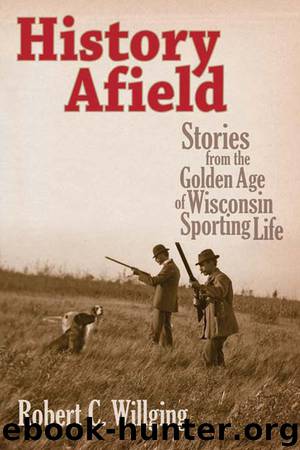History Afield by Robert C. Willging

Author:Robert C. Willging
Language: eng
Format: epub
Publisher: Wisconsin Historical Society Press
Chapter 17
One Day in March 1933
Every one of us has a story—a story of that one incident, that most exciting event in our lives. It is the story we tell and retell through the years and somehow becomes its own entity. It becomes “Dad's story” or “Uncle Joe's story,” guaranteed to be heard at gatherings of old friends, or family reunions, or just over any late-night cup of coffee.
The event that was to become Vern Frechette's story, a story he has told countless times during the past seventy years, had its subtle birth on what looked to be a pretty fair morning for fishing in early March 1933.
Frechette is ninety-three years old now and lives in an apartment in Washburn, the small town directly across Chequamegon Bay from Ashland. He can't get around as he used to, or as he'd like to. His knees bother him, and he can't drive anymore. The years have robbed him of much of his hearing. He misses the outdoors—the hunting and the fishing that took him to every quiet corner of the Bayfield Peninsula. Born and raised on Chequamegon Bay, he knew it better than most. He also knew the offshore waters and the sometimes-calm, sometimes-angry waters between the Apostles—Long Island, Madeline, Michigan—waters fished heavily by Frechette and other locals and today often plied by tourists in big boats.
The morning of March 9 looked like a pretty good morning to get out on the ice, and Vern, his brother George, and friend Oscar Holman navigated a Model T to the ice between the northeast end of Madeline Island and Michigan Island. About ten other men from Washburn and a handful from Ashland were also on the ice that day.
The men were after big lake trout, the heavy fish that could feed a family or be sold over at Cornucopia sometimes for twenty-three cents a pound. Lake trout run deep, and fishing for them in the 1930s meant using a big bobbing hook and heavy “tarred” line.
“What we did was take shoemaker's twine and twist two or three strands together, and then we stretched it out and tarred it,” Frechette told me. “It held up pretty good, but you had to check on it pretty often.”1
Store-bought hooks were rare back then. The hooks were sometimes fashioned from the tines of a pitchfork. “Those hooks didn't have eyelets on them like today,” Frechette said. “We attached the line to the hook by wrapping the end with thread and then sealing it with nail polish.” He continued, “We tied on a heavy lead sinker shaped like a cone and used cut bait—cut up herring and such—for bait.”
Trout fishing on Lake Superior ice in early March was serious business. But the threat of a storm coming up from the southwest was big business, too, and when the wind began to blow across the ice the Frechette brothers knew just what to do—pack up and get to land as fast as possible.
As they drove the Model T toward Long
Download
This site does not store any files on its server. We only index and link to content provided by other sites. Please contact the content providers to delete copyright contents if any and email us, we'll remove relevant links or contents immediately.
Backpacker the Complete Guide to Backpacking by Backpacker Magazine(2193)
Capital in the Twenty-First Century by Thomas Piketty(1949)
The Isle of Mull by Terry Marsh(1899)
Predation ID Manual by Kurt Alt(1658)
The Collected Non-Fiction by George Orwell(1574)
Small-Bore Rifles by C. Rodney James(1505)
All Fishermen Are Liars by John Gierach(1447)
Backcountry Bear Basics by Dave Smith(1434)
Creative Confidence by Tom Kelley(1417)
The Art of Throwing by Amante P. Marinas Sr(1355)
50 Famous Firearms You've Got to Own by Rick Hacker(1342)
Blood Mountain by J.T. Warren(1304)
Archery: The Art of Repetition by Simon Needham(1303)
Long Distance Walking in Britain by Damian Hall(1280)
The Scouting Guide to Survival by The Boy Scouts of America(1252)
Backpacker Long Trails by Backpacker Magazine(1248)
The Fair Chase by Philip Dray(1226)
The Real Wolf by Ted B. Lyon & Will N. Graves(1212)
The Ultimate Guide to Home Butchering by Monte Burch(1205)
